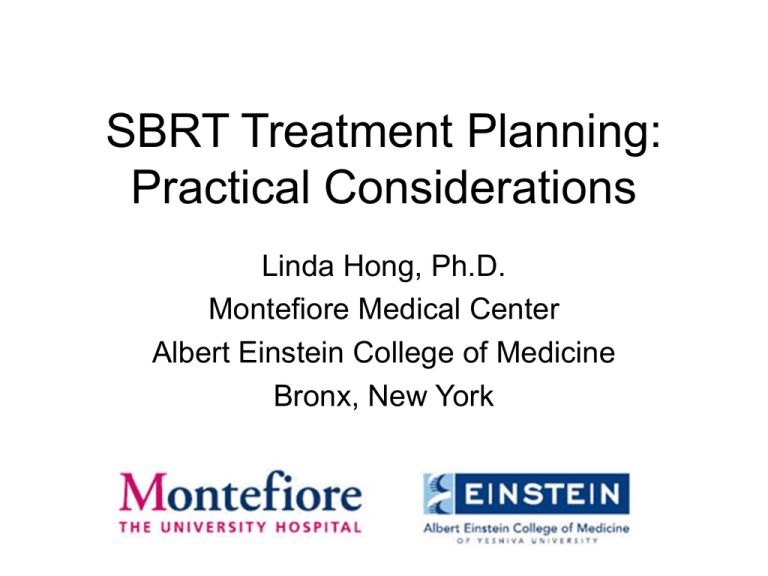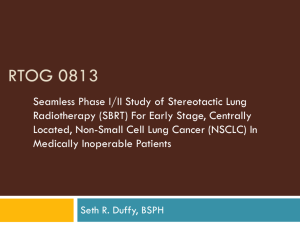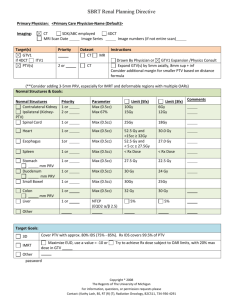SBRT Treatment Planning: Practical Considerations Linda Hong, Ph.D. Montefiore Medical Center
advertisement

SBRT Treatment Planning: Practical Considerations Linda Hong, Ph.D. Montefiore Medical Center Albert Einstein College of Medicine Bronx, New York I have no conflicts of interest to disclose. Outlines • The Basic Principles of SBRT Treatment Planning Conventional fractionated plan vs. SBRT plan Cranial SRS plan vs. SBRT plan • Practical Considerations on SBRT Treatment Planning Spine Lung Liver • Lessons learned from our experiences Stereotactic Body Radiation Therapy (SBRT) • Fractional dose >5Gy range: 5 Gy to 34 Gy per fraction • Number of fractions <5 range: 1 to 5 • Safe delivery is of utmost importance due to high fractional dose and small number of fractions. Montefiore-Einstein SBRT Experiences Started 1st SBRT Spine 1/2008 Started 1st SBRT Lung 4/2008 Started 1st SBRT Liver 8/2008 About 2 new SBRT cases weekly ever since • Machines Varian Trilogy or Truebeam • Eclipse TPS • • • • Montefiore-Einstein Cancer Center (MECC) SBRT Registry Spine 1-3 lesions • Single Fraction: 16 Gy • Three Fraction: 24 Gy (8 Gy per fraction) Lung Peripheral Lesions • Three fractions: 60 Gy (20 Gy per fraction) Central Lesions • Five fractions: 50 Gy (10 Gy per fraction) Liver Metastasis • If lesions > 2cm from Porta Hepatis/Bile Duct: Three Fractions 20Gy x 3 • If lesions ≤ 2cm from Porta Hepatis/Bile Duct: Five Fractions 10Gy x 5 Hepatocellular Carcinoma • Five fractions: 30-50 Gy (depends on Veff) RTOG SBRT Protocols • 0631 Spine • 0813 and 0915 Lung • 0438 Liver These protocols specify detailed requirements for treatment planning: Dose Prescription Target Coverage Dose Constraints The Basics of Treatment Planning for SBRT • The goal of SBRT treatment is to “ablate” tissues within the PTV, these tissues were not considered at risk for complications. Dose inhomogeneity inside the PTV was considered acceptable (potentially advantageous) and not considered a priority in plan design. Maximum point dose up to 160% of Prescription Dose is common for SBRT plans. • The main objective of the plan is to minimize the volume of those normal tissues outside PTV receiving high dose per fraction. If beam margin is close to beam penumbra (5-6 mm)→ Homogeneous PTV dose, Maximum dose about 110% of Prescription Dose (PD). Dose fall off outside PTV is slow Beam Margin PTV PTV If beam margin is much less than beam penumbra (0-2 mm) → Inhomogeneous PTV dose, Maximum dose ~ 125% or more of PD. Dose fall off outside PTV is fast Beam Margin PTV PTV Cranial SRS Planning FIG. 1. Homogeneity index (Ratio of Maximum PTV Dose to the PD) vs. beam margin. FIG. 3. a Conformity index (Ratio of PD Volume to PTV Volume) vs. homogeneity index. Hong et al.: LINAC-based SRS: Inhomogeneity, conformity, and dose fall off, Med. Phys., Vol. 38, No. 3, March 2011 For single isocenter dose distributions, the dose fall-off from prescription isodose to half of the prescription dose typically occurs over the shortest distance if the dose is prescribed to the 80% isodose shell, with 100% as maximum dose. If 100% is PD, then 125% should be the maximum dose to have sharpest ratio of R50% (Ratio of 50% Prescription isodose volume to the PTV volume) Sanford L. Meeks et al Int. J. Radia. Onc. Biol. Phys., Vol. 41, No. 1, pp. 183–197, 1998 Normal Tissue Volume receiving 50% of PD increases sharply as PTV inhomogeneity decreases below 120% of PD Hong et al.: LINAC-based SRS: Inhomogeneity, conformity, and dose fall off, Med. Phys., Vol. 38, No. 3, March 2011 Conventional SBRT (Ablative intent) PD per fraction 3Gy or less 5 Gy or more # of fractions 10 or more 5 or less Dose Distribution Homogeneous (maximum PTV dose ~ 110%) Heterogeneous (maximum PTV dose up to 160%) Dose Gradient outside PTV Shallow slope Steep slope 20Gy x 3 plan is different from 2Gy x 30 plan a small lung lesion example (PTV volume 33cc) SBRT Conventional 11 11 3 Beam Margin (mm) 1 5 5 PD per fraction 2 Gy 2 Gy Max PTV Dose (%) 124.2% 110.8% 110.0% V100% 38.6 cc 44.3 cc (5.7 cc more) 87.5 cc (48.9 cc more) V50% (R50%) 146.3 cc (4.4) 212.4 cc (6.4) (66cc more) 417.3 cc (12.6) (271 cc more) V 25% 630.4 cc 799.2 cc (169 cc more) 756.8 cc (126 cc more) 50% PD 10 Gy 1 Gy 1 Gy # of Beams 20 Gy All Plans normalized to PTV V100% = 95% For SBRT plans Prescription Isodose level is usually not 100% PD covering 100% PTV Often 95% PD covering 95% PTV or higher Or 100% PD covering 95% PTV or higher This coverage was chosen because of the increased tissue volumes that must be irradiated to cover the corners of the PTV on each consecutive CT slice if 100% coverage is required. For conventional plans Often 100% PD dose to 100% PTV SBRT planning principles are very similar to Cranial SRS planning principles • Inhomogeneous Dose inside PTV • Sharp Dose Fall Off outside PTV • Multiple non-coplanar beams or arcs are needed to create conformal dose distributions. Much more limited non-coplanar beam clearance compared with cranial SRS for LINAC based SBRT. Requirements of SBRT Plan (from RTOG 0813 and 0915 lung protocols) • Maximum Dose: normalized to 100%, must be within PTV • Prescription Isodose: must be ≥ 60% and < 90% of the maximum dose • Prescription Isodose Surface Coverage: 95% of the target volume (PTV) is conformally covered by the prescription isodose surface (PTV V100%PD = 95%) and 99% of the target volume (PTV) receives a minimum of 90% of the prescription dose (PTV V90%PD > 99%) • High Dose Spillage: The cumulative volume of all tissue outside the PTV receiving a dose > 105% of prescription dose should be no more than 15% of the PTV volume • Intermediate Dose Spillage: The falloff gradient beyond the PTV extending into normal tissue structures must be rapid in all directions and meet the criteria in Table1 • Meet the constraints of dose limiting organs at risk RTOG 0813 (lung) and RTOG 0915 (lung) Table1 The published protocols usually do not specify R50% or D2cm requirements for spine and liver cases. Nevertheless, we find lung protocol criteria useful for spine and liver cases as well. RTOG 0631 (Spine) Definition of Spine Metastasis Target Volume Figure 2: Diagram of Spine Metastasis and Target Volume An epidural lesion is included in the target volume provided that there is a ≥ 3 mm gap between the spinal cord and the edge of the epidural lesion. RTOG 0631 (Spine) 10cm Conventional Cord 10cm Max point dose Montefiore-Einstein Cancer Center SBRT Registry Study Spine 1-3 lesions • Single Fraction: 16 Gy (RTOG 0631) (for cases we have confidence in setup, for example: inferior T-spine and L-spine lesions) • Three Fraction: 24 Gy (8 Gy per fraction) (for cases with setup uncertainty large, for example: C-spine and superior T-spine lesions) For Spine Cases: IMRT or VMAT is required to create concave dose distributions. We use two full RapidArcs, or two partial RapidArcs to avoid shoulders or arms, one arc with collimator at 0, the other with collimator at 90. Multiple fixed IMRT fields can be used. No need to do any non-coplanar beams (no clearance anyway). We follow RTOG 0813 and RTOG 0915 lung protocols criteria for PTV coverage, high dose spillage and dose fall off Maximum Dose: must be within PTV Prescription Isodose: If PD = 100%, maximum dose must be at least 111.11% but not more than 166.67% Prescription Isodose Surface Coverage: 95% of the target volume (PTV) is conformally covered by the prescription isodose surface (PTV V100% = 95%) and 99% of the target volume (PTV) receives a minimum of 90% of the prescription dose (PTV V90% > 99%) V100% = 95% V90% > 99% Cord: Max point dose 9.33 Gy Prescription Isodose Surface Coverage: CAX PD = 100% = 16 Gy PTV V100 = 95% PTV V100 = 95% 100% PD and Above PTV 2cm-3cm ring Cor Sag Prescription Isodose Surface Coverage: PD = 100% = 16 Gy CAX PTV V90% > 99% Here PTV V90% = 100% 90% PD and Above COR SAG High Dose Spillage: PD = 100% = 16 Gy Max PTV dose = 135.3% CAX 105% covered volumes outside of PTV <= 15% of volume of PTV Here PTV = 19.1cc V105-PTV = 1.4 cc (7.3%) 105% PD and Above Cor Sag Conformality : Prescription Dose Volume vs. PTV Volume PD = 100% = 16 Gy CAX V100 / PTV volume <= 1.2 Here PTV = 19.1cc V100 = 21.7 cc Ratio = 1.14 100% PD and Above Cor Sag Intermediate Dose Spillage: R50% and D2cm CAX For PTV = 19.1 cc R50% < 4.6; D2cm = 52.7% Here V50% = 77.0 cc R50% = 4.0 D2cm = 43.6% 50% PD and Above COR SAG R50% : Ratio of 50% PD volume/PTV volume D2cm : Maximum dose in % of PD at 2cm beyond PTV in any direction CAX No need to do any non-coplanar beams (no clearance anyway). 25% PD and Above COR SAG 12.5% PD and Above CAX Cor 16Gy x 12.5% = 2Gy SAG Single Arc Collimator 45 CAX COR SAG 100% PD and Above Two Arcs: Collimator 0 and 90 CAX COR PTV SAG 2cm-3cm ring Single Arc Collimator 45 CAX Two Arcs: Collimator 0 and 90 CAX COR SAG 50% PD and Above SAG COR PTV 2cm-3cm ring Additional 15 cc volume of normal tissue receiving 5% PD CAX COR SAG 5% PD and Above Single Arc Collimator 45 CAX Two Arcs: Collimator 0 and 90 COR PTV SAG 2cm-3cm ring Coll 45 Jaw opening area twice as much When compared to collimator At 0 or 90. More leakage dose in Superior and inferior beyond PTV. Leaves parked inside jaws when Unused for RapidArc Coll 90 Coll 0 Fixed IMRT Fields 100% PD and above 50% PD and above 11 fixed field IMRT Can meet similar R50% and D2cm constraints 25% PD and above 12.5% PD and above Fixed IMRT Fields: 7-9 posterior beams 9 Field IMRT Sometimes difficult to meet CAX R50% and D2cm constraints if you use those constraints. 50% PD and Above COR SAG Cord: Sometimes difficult to meet 10Gy constraints, even though max point dose 14Gy can be met. 9 Field IMRT: Cord Dose DVH RTOG 0631 Criteria: 10 Gy 0.99cc 10 Gy 11.9% 10 Gy covers <= 0.35cc AND 10 Gy covers <= 10% AND 14 Gy covers <= 0.03cc (Montefiore Max point dose 14Gy) Max point cord dose: 12.4 Gy Montefiore-Einstein Cancer Center SBRT Registry Study Lung Peripheral Lesions • Three fractions: 60 Gy (20 Gy per fraction) (Based on RTOG 0618) Central Lesions • Five fractions: 50 Gy (10 Gy per fraction) (Based on RTOG 0813) For Lung cases, it is often necessary to have non-coplanar beams to achieve fast dose fall off. We use three partial arc VMAT technique Each arc at least 100 degree Non-coplanar couch angle up to 20 degree Non-coplanar multiple IMRT or 3DCRT beams can be also used. Arc2: Couch 15, Gantry 330-110 Arc1: Couch 0, Gantry 179-30 Arc3: Couch 345, Gantry 110-330 Arc 2 and Arc 3 are mostly anterior arcs to gain clearance MECC SBRT Registry: Lung Constraints Three Fraction (20Gy x 3) (Based on dose of RTOG 0618): Heart: Maximal point dose is 30 Gy (10 Gy per fraction) Ipsilateral brachial plexus: Maximal point dose is 24 Gy (8 Gy per fraction) Spinal Cord: Maximal point dose is 18 Gy (6 Gy per fraction) Esophagus: Maximal point dose is 27 Gy (9 Gy per fraction). Trachea/ipsilateral bronchus: Maximal point dose is 30 Gy (10 Gy per fraction) Whole lung minus GTV: V20<10%; Skin: Maximal point dose is 24 Gy (8 Gy per fraction) Ribs: Goal is 30cc of chest wall volume <30 Gy without compromising PTV coverage Prescription Isodose Surface Coverage: CAX PD = 100% = 20 Gy/fx x 3 PTV V100 = 95% PTV V100 = 95% 100% PD and Above Cor Sag Prescription Isodose Surface Coverage: PD = 100% = 20 Gy/fx x 3 CAX PTV V90% > 99% Here PTV V90% = 100% 90% PD and Above COR SAG High Dose Spillage PD = 100% = 20 Gy/fx x 3 Max PTV dose = 135.0% 105% covered volumes outside of PTV <= 15% of volume of PTV Here PTV = 40.2 cc V105-PTV = 0.1 cc (0.2 %) 105% PD and Above Conformality : Prescription Dose Volume vs. PTV Volume CAX PD = 100% = 20 Gy/fx x 3 V100 / PTV volume <= 1.2 Here PTV = 40.2 cc V100 = 41.0 cc Ratio = 1.02 100% PD and Above COR SAG Intermediate Dose Spillage: R50% and D2cm For PTV = 40.2 cc R50% <= 4.2; D2cm = 59.6% CAX Here V50% = 169.5 cc R50% = 4.2 D2cm = 52.6% 50% PD and Above COR SAG 25% isodose restricted mainly in the ipsilateral lung 25% PD and Above 12.5% isodose restricted mainly in the ipsilateral lung 12.5% PD and Above MECC SBRT Registry: Lung Constraints Five Fraction(10Gy x 5) Based on RTOG 0813: Heart: <15cc receives ≥32 Gy (6.4 Gy/fx); maximum point dose ≤52.5 Gy Trachea/ipsilateral bronchus (non-adjacent wall): <4 cc receives ≥18 Gy (3.6 Gy/fx); maximum point dose ≤52.5 Gy Great vessels (non-adjacent wall): <10 cc receives >47 Gy (9.4 Gy per fraction); maximum point dose ≤52.5 Gy Ipsilateral brachial plexus: <3 cc receives ≥ 30 Gy (6 Gy/fx); maximum point dose ≤32 Gy (6.4 Gy per fraction) Spinal Cord: <0.25 cc receives≥ 22.5 Gy (4.5 Gy/fx) <0.5 cc receives≥ 13.5 Gy (2.7 Gy/fx)] Maximal point dose is 30 Gy (6 Gy per fraction) Esophagus: <5 cc receives ≥27.5 Gy (5.5 Gy per fraction); maximum point dose ≤52.5 Gy Whole lung minus GTV: <1500 cc receives ≥12.5 Gy (2.5 Gy per fraction) <1000 cc receives ≥13.5 Gy (2.7 Gy per fraction) Skin: <10 cc receives ≥30 Gy (6 Gy/fx). Maximal point dose is 32 Gy (6.4Gy per fraction) Same beam arrangements/techniques can be used as peripherally located tumor. Montefiore-Einstein Cancer Center SBRT Registry Study Liver Metastasis If lesions > 2cm from Porta Hepatis/Bile Duct: Three Fractions 20Gy x 3 If lesions ≤ 2cm from Porta Hepatis/Bile Duct: Five Fractions 10Gy x 5 HCC • Five fractions: 30-50 Gy (depends on Veff) Dose per fraction • Veff < 0.3 10 Gy x 5 0.3 - 0.4 9 Gy x 5 0.4 - 0.5 8 Gy x 5 0.5 - 0.6 6 Gy x 5 Dawson LA et al Acta Oncol 45:856, 2006 Same beam arrangements/techniques can be used as lung SBRT. MECC SBRT Registry: Liver Constraints Metastasis If lesions > 2cm from Porta Hepatis/Bile Duct: Three Fractions 20Gy x 3 If lesions ≤ 2cm from Porta Hepatis/Bile Duct: Five Fractions 10Gy x 5 Liver minus-GTV: >700mL receive <15 Gy Heart: <15cc receives ≥32 Gy; maximum point dose ≤52.5 Gy Lung: <1000 cc receives ≥11.4 Gy (3.8 Gy/fx) Esophagus: Maximal point dose is 27 Gy (9 Gy per fraction) Stomach/Duodenum/Small Bowel: Maximal point dose 30 Gy Kidney: ≤1/3 volume (sum of left and right) receives ≥15 Gy; V6 < 10% Colon/Rectum: Maximal dose 34 Gy to 0.5 cc Spinal Cord: Maximal point dose is 18 Gy (6 Gy per fraction) Skin: Maximal point dose is 24 Gy (8 Gy per fraction) MECC SBRT Registry: Liver Constraints Hepatocellular Carcinoma Five Fractions Stereotactic body radiation therapy: The report of AAPM Task Group 101 Stanley H. Benedict et al Med. Phys. 37 (8), August 2010 Detailed information about SBRT SBRT CT simulation • For upper thoracic regions, both arms (elbows) should be over the patient’s head and included in the CT scan so that clearance of beams can be visualized during planning. • Scan 15 cm beyond field borders (sometimes non-coplanar beams are needed). • For spine cases, include sacrum for lower spine or include C1 for upper spine so that vertebrae can be easily identified. SBRT C-Spine • CT scan has to include C1 • Setup uncertainty large due to flexibility in neck area • Fusion with MRI might be difficult because of different neck position • 2-3mm margin should be added for PTV • Hypofractionation preferred instead of single fraction – unless significant cord clearance • We use BlueBAGTM with vacuum suction plus head and neck mask as immobilization device SBRT T-Spine • CT scan has to either include C1 or L Spine • Arms on the side preferred so that patient can stay comfortable • Beams avoid arms • We use BlueBAGTM with vacuum suction as immobilization device SBRT L-Spine • CT has to include Sacrum • Arms on chest instead of up for comfort • We use BlueBAGTM with vacuum suction as immobilization device SBRT Lung/Liver/Abdominal Cases • 4DCT simulation must be done first to access tumor motion range • Gating will be considered only if motion > 0.5cm, and the patient has a regular, reproducible breathing pattern; alternatively, an ITV can be created. • For gating cases, BlueBAGTM without vacuum suction is used as immobilization device. • Abdominal Belt Compression system can be used for some patients • Fiducials necessary for Liver/Abdominal Cases: no other way to visualize tumor. CBCT image quality, FOV limitation for lateral tumors. • If no fiducials for Lung cases, Fluoro on the machine must be done before simulation to verify visualization of tumor SBRT Lung/Liver/Abdominal Cases • If non-gating, may consider one or both arms on the side. Non-coplanar beams could be used to compensate for lateral beams. If gating is used, only coplanar beams can be used for some machines, arms on the side could further limits beams. • VMAT is a good option (can not be combined with gating for many machines) • Gating + fixed beam IMRT or EDW is not advisable (takes way too long to deliver), use FIF instead if you must. • Beam arrangement should consider collision possibility for lateral tumors. Keep beams /arcs on the ipsilateral side. SBRT Lung/Liver/Abdominal Cases • If no fiducials, create fluoro beam aperture that hugs GTV. • If there is fiducials, create fluoro beam aperture that use fiducials as corners. • CBCT alignment with GTV, bony landmark secondary but should be less than 1cm discrepancy. Otherwise, reposition patient. • CBCT sometimes do not align well with average sim CT due to breathing variation • Fluoro to verify positioning after CBCT. • Fluoro between fields to monitor setup consistency. Under fluoro: only the MLC shape outline (hugs GTV) will be visible on screen When the shape turns green, beam is on. GTV is visible on screen when fluoro is on. Our goal is to for GTV to match MLC shape when beam is on. After 5mm superior shift. GTV is 5mm too inferior (MLC acts as a scale). CBCT was done with free breathing (non-gated), therapist did not align superior part of CBCT with Gated CTsim tumor during image fusion. At one different angle During treatment (a Total of 3 was done during treatment). Bottom line for SBRT • Without an approved plan in the patient’s chart, no treatment verification can be done. Physics must be present for treatment verification. • If IMRT, without IMRT QA documented, no 1st treatment should be done. • Attending must be present for every treatment fraction. Physics should be available for every treatment. What is a ‘Dry Run’? • Treatment verification – Reproduce setup – Verify isocenter – Clinically mode up each treatment field Check beam clearance (collision) Check any interlock MLC interlock? Reinitialized but can not clear means corruption of MLC files undeliverable beam Potential MU problem? For example > 1000 for any single field beyond machine capability for non-SRS beams Clearly mark immobilization devices after successful dry run. Summary • RTOG protocols are useful guidelines for treatment planning for SBRT • SBRT procedures from CT simulation to treatment planning to treatment verification and treatment warrant serious attention from everyone involved. Establishing clear protocols for your own institution is necessary for the safe delivery of SBRT. Acknowledgements • Physics Jin Shen Joe Lee Aleiya Gafa Paola Godoy-Scripes Jack Kessel Dinesh Mynampati Kuo, Hsiang-Chi Ravindra Yaparpalvi Wolfgang Tome • Physicians William Bodner Madhur Garg Jana Fox Maury Rosenstein Keyur Mehta Chandan Guha Shalom Kalnicki Thank You




